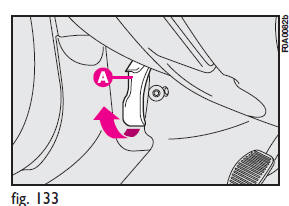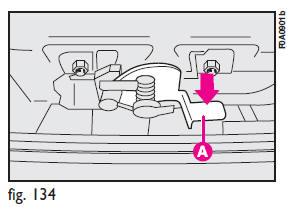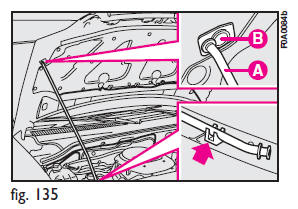To open the bonnet
![]() This should only be done when the vehicle is stationary.
This should only be done when the vehicle is stationary.
Before opening the bonnet, check the windscreen wiper arms are not lifted from the windscreen.
1) Pull the yellow lever A-fig. 133 in the direction of the arrow.
2) Raise the bonnet slightly until locating the release lever.

3) Press the fastener A-fig. 134, as shown in the figure.
4) Open the bonnet and release the rod A-fig. 135 from its clip at the same time. Then B on the bonnet.
![]() Important. The bonnet might fall violently if the support rod is not positioned
properly.
Important. The bonnet might fall violently if the support rod is not positioned
properly.


![]() When the engine is hot, mind your hands when working inside the engine compartment
to avoid burning yourself. Never put your hands near the fan: it could start up
even without the key in the switch.
When the engine is hot, mind your hands when working inside the engine compartment
to avoid burning yourself. Never put your hands near the fan: it could start up
even without the key in the switch.
Wait until the engine cools down.
![]() Take care that scarves, ties or loose clothing do not accidentally come near
moving parts; they could become entangled with serious danger for the wearer.
Take care that scarves, ties or loose clothing do not accidentally come near
moving parts; they could become entangled with serious danger for the wearer.
To close the bonnet
1) Hold the bonnet up with one hand and, with the other, remove rod Afig.
135 from recess B and replace it in its clip.
2) Lower the bonnet until it is about 20 cm above the engine compartment, and then let it drop, ensuring that it is fully closed and not just held in position by the safety catch.
If the bonnet does not close properly do not push it down but open it again and repeat the above procedure.
![]() For safety reasons the bonnet must be closed properly to avoid its opening
while the vehicle is traveling.
For safety reasons the bonnet must be closed properly to avoid its opening
while the vehicle is traveling.
Therefore, always check it is properly closed and the catch engaged. Should you notice that the catch is not perfectly engaged when traveling, stop the vehicle immediately and close the bonnet.
See also:
Additional braking light (third stop)
To change the bulb, proceed as follows:
❒ open the tailgate and loosen screws (A);
❒ release the clip (B) and open the bulb holder, the remove the bulb (C) to be replaced
(clippe ...
Sentry Key
The Sentry Key Immobilizer System prevents unauthorized vehicle operation by
disabling the engine. The system does not need to be armed or activated. Operation
is automatic, regardless of whether ...
Rear Head Restraints
To raise the head restraint, pull upward on the head restraint. To lower the
head restraint, press the push button, located at the base of the head restraint,
and push downward on the head restrai ...


